Fix Windows Modules Installer Worker High CPU Usage
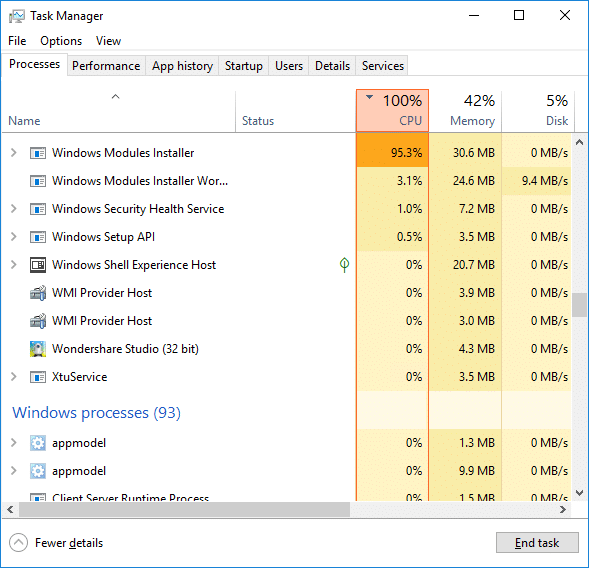
If you are facing the High CPU Usage by Windows Modules Installer Worker, then don’t worry as thousands of other users are also facing the similar problem and therefore, there are many working fixes which we will be discussing today in this article. To verify if you are facing this issue open Task Manager (Ctrl + Shift + Esc) and you will find that the Windows Modules Installer Worker is consuming High CPU or Disk Usage.

හිතවාදී ඉඟිය: You may leave your PC overnight or for a few hours to see the issue rectify itself once the Windows is finished downloading and installing updates.
What is Windows Modules Installer worker (WMIW)?
Windows Modules Installer worker (WMIW) is a service which takes cares of automatically installing Windows Update. According to its service description, WMIW is a system process that enables automatic installation, modification, and removal of Windows updates and optional components.
This process is responsible for finding new Windows Update automatically and installing them. As you might be aware that Windows 10 automatically install newer builds (i.e. 1803 etc.) via Windows Updates, so this process is responsible for installing these updates in the background.
Although this process is called Windows Modules Installer worker (WMIW) and you will see the same name in the Processes tab in the Task Manager, but if you switch to Details tab, then you will find the name of the file as TiWorker.exe.
Why Is Windows Modules Installer worker Using So Much CPU?
As Windows Modules Installer worker (TiWorker.exe) runs continuously in the background, sometimes it might utilize high CPU or disk usage when installing or uninstalling Windows Updates. But if its constantly using high CPU then the Windows Modules Installer worker may have become unresponsive while checking new updates. As a result, you may be experiencing lags, or your system might hang or freeze completely.
The first thing users do when they experience freezing, or lagging issues on their system is to restart their PC, but I assure you that this strategy won’t work in this case. This is because the issue will not resolve by itself until and unless you fix the underlying cause.
Fix Windows Modules Installer Worker High CPU Usage
යම් දෙයක් වැරදී ගියහොත් ප්රතිසාධන ලක්ෂ්යයක් සෑදීමට වග බලා ගන්න.
Windows Modules Installer Worker (WMIW) is an important service, and it should not be disabled. WMIW or TiWorker.exe is not a virus or malware, and you cannot just delete this service from your PC. So without wasting any time let’s see How to Fix Windows Modules Installer Worker High CPU Usage පහත ලැයිස්තුගත දෝශ නිරාකරණ මාර්ගෝපදේශයේ සහාය ඇතිව.
ක්රමය 1: වින්ඩෝස් යාවත්කාලීන දෝශ නිරාකරණ ධාවනය කරන්න
1. විවෘත කිරීමට Windows Key + I ඔබන්න සැකසුම් ඉන්පසු ක්ලික් කරන්න යාවත්කාලීන සහ ආරක්ෂක නිරූපකය.
![]()
2. වම් පස මෙනුවෙන්, තෝරන්න දෝෂයකි යටතේ "නැඟිට දුවන්න” ක්ලික් කරන්න වින්ඩෝස් යාවත්කාලීන කිරීම.

3. දැන් “මත ක්ලික් කරන්නදොස්හාරකය ක්රියාත්මක කරන්න” under Windows Update.
4. Let the troubleshooter run, and it will automatically fix any issues found with Windows Update taking forever.
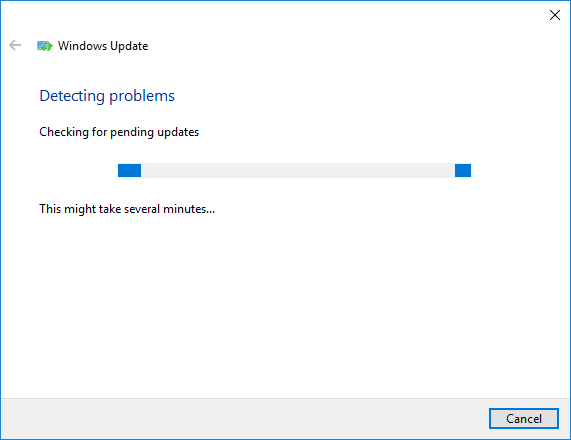
Method 2: Manually Check for Windows Updates
1. Windows Key + I ඔබන්න ඉන්පසු තෝරන්න යාවත්කාලීන කිරීම සහ ආරක්ෂාව.
2. වම් පස සිට, මෙනුව ක්ලික් කරන්න වින්ඩෝස් යාවත්කාලීන කිරීම.
3. දැන් ක්ලික් කරන්න "යාවත්කාල කිරීම් සඳහා පරීක්ෂා කරන්නලබා ගත හැකි යාවත්කාලීනයන් පරීක්ෂා කිරීමට ” බොත්තම.

4. කිසියම් යාවත්කාලීනයක් පොරොත්තු නම්, පසුව ක්ලික් කරන්න යාවත්කාලීන බාගත කර ස්ථාපනය කරන්න.

5. යාවත්කාලීනයන් බාගත කළ පසු, ඒවා ස්ථාපනය කරන්න, එවිට ඔබේ වින්ඩෝස් යාවත්කාලීන වේ.
Method 3: Configure Windows Update to Manual
අනතුරු ඇඟවීමකි: This method will switch Windows Update from automatically installing the new updates to the manual. This means you have to manually check for Windows Update (weekly or monthly) to keep your PC secure. But follow this method, and you can again set the Updates to Automatic once the issue is resolved.
1.Windows Key + R ඔබා ඉන්පසු ටයිප් කරන්න services.msc හා Enter.

2. Scroll down and find වින්ඩෝස් මොඩියුල ස්ථාපකය service in the list.
3. දකුණු-ක්ලික් කරන්න Windows Modules Installer service තෝරන්න දේපළ.
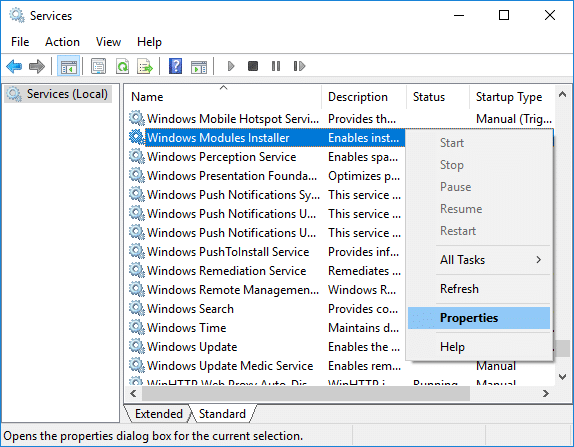
4. දැන් ක්ලික් කරන්න නවත්වන්න then from the ආරම්භක වර්ගය drop-down select අත්පොත.
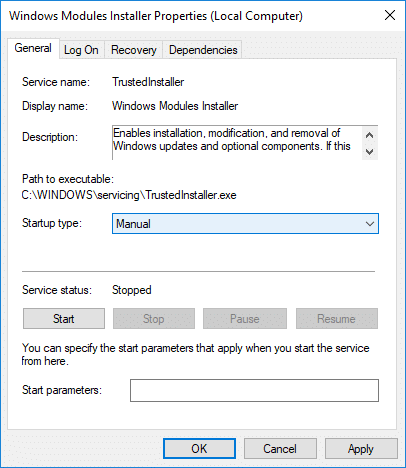
5. අයදුම් කරන්න ක්ලික් කරන්න, ඉන්පසු හරි.
6. Similarly, follow the same step for the Windows Update service.

7. වෙනස්කම් සුරැකීමට ඔබේ පරිගණකය නැවත ආරම්භ කරන්න.
8. නැවතත් සඳහා පරීක්ෂා කරන්න Windows Updates Manually and install any pending updates.
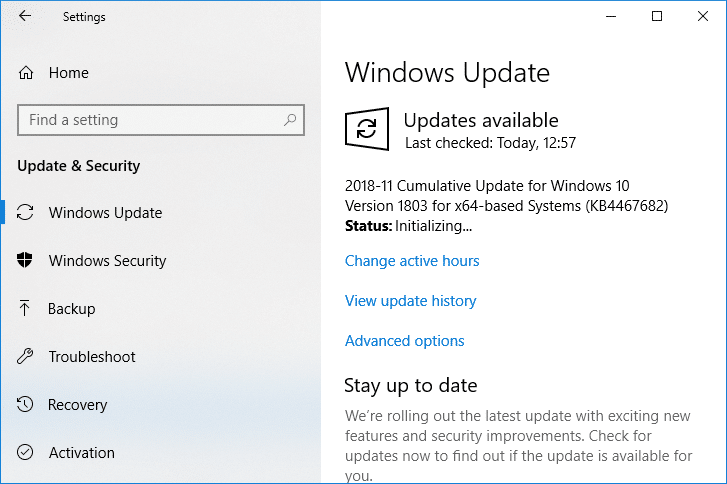
9. Once is done, again go back to services.msc window and open the Windows Modules Installer & Windows Update Properties කවුළුව.
10. සකසන්න ආරම්භක වර්ගය දක්වා ස්වයංක්රීය ක්ලික් කරන්න ආරම්භයක්. Then click Apply followed by OK.
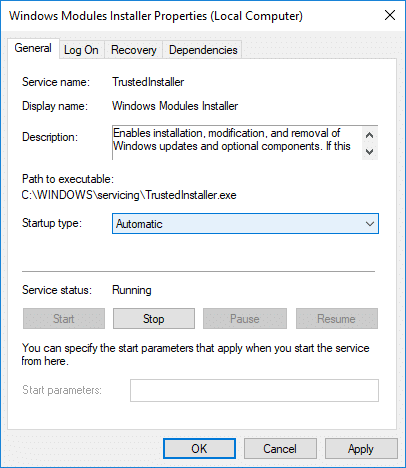
11. වෙනස්කම් සුරැකීමට ඔබේ පරිගණකය නැවත ආරම්භ කරන්න.
ක්රමය 4: පද්ධති නඩත්තු දෝශ නිරාකරණ ධාවනය කරන්න
1. Windows Key + R ඔබා ඉන්පසු පාලනය ටයිප් කර Enter ඔබන්න විවෘත කරන්න පාලන පුවරුව.

2. දෝශ නිරාකරණය සොයන්න සහ ක්ලික් කරන්න දෝෂගවේෂණය.

3. ඊළඟට, ක්ලික් කරන්න දැක්ම සියලු වම් කවුළුව තුළ.
4. මත ක්ලික් කරන්න “System Maintenance” ධාවනය කිරීමට System Maintenance Troubleshooter.

5. දෝශ නිරාකරණය කරන්නාට හැකි විය හැක Fix Windows Modules Installer Worker High CPU Usage, but if it didn’t, then you need to run System Performance Troubleshooter.
6. විධාන විමසුම විවෘත කරන්න. යන්න සෙවීමෙන් පරිශීලකයාට මෙම පියවර සිදු කළ හැක 'cmd' ඉන්පසු Enter ක්ලික් කරන්න.

7. පහත විධානය cmd වෙත ටයිප් කර Enter යතුර ඔබන්න:
msdt.exe / id කාර්ය සාධනකාරිත්වය
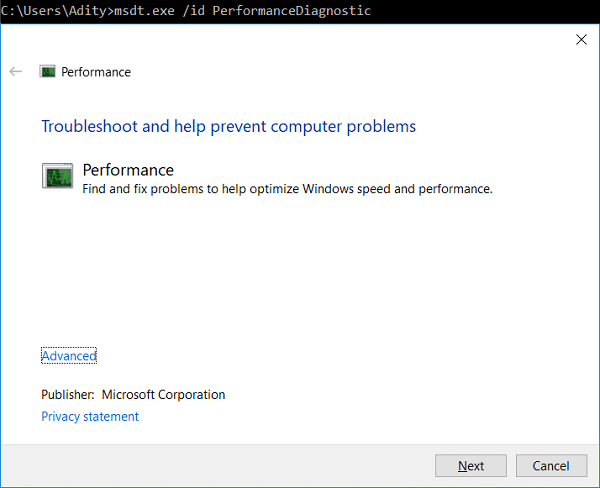
8. Follow the on-screen instruction to run the troubleshooter and fix any issues find the System.
9. Finally, exit the cmd and reboot your PC.
Method 5: Disable Automatic Maintenance
Sometimes Automatic Maintenance can conflict with the Windows Modules Installer Worker service, so try to disable Automatic Maintenance using this guide and see if this fixes your issue.
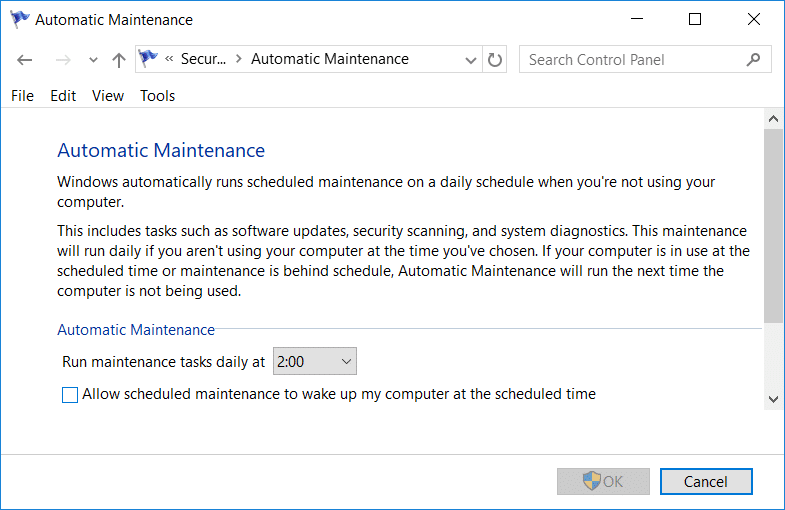
Although disabling Automatic Maintenance is not a good idea, but there might be some case where you need to actually disable it, for example, if your PC freezes during automatic maintenance or Windows Modules Installer Worker High CPU Usage issue then you should disable maintenance to troubleshoot the issue.
Method 6: Run System File Checker and ඩිස්එම්
1. විධාන විමසුම විවෘත කරන්න. යන්න සෙවීමෙන් පරිශීලකයාට මෙම පියවර සිදු කළ හැක 'cmd' ඉන්පසු Enter ක්ලික් කරන්න.
2.දැන් cmd එකේ පහත දේ ටයිප් කර enter ඔබන්න:
Sfc / scannow sfc / scannow /offbootdir = c: /offwindir = c:windows (ඉහත අසාර්ථක නම් මෙය උත්සාහ කරන්න)

3. ඉහත ක්රියාවලිය අවසන් වන තෙක් රැඳී සිට අවසන් වූ පසු, ඔබේ පරිගණකය නැවත අරඹන්න.
4. නැවතත් cmd විවෘත කර පහත විධානය ටයිප් කර එක් එක් එකට පසුව enter ඔබන්න:
ඩිස්ම් / ඔන්ලයින් / ක්ලීනප්-ඉමේජ් / චෙක්හෙල්ත් ඩිස්ම් / ඔන්ලයින් / ක්ලීනප්-ඉමේජ් / ස්කෑන් හෙල්ත් ඩිස්ම් / ඔන්ලයින් / ක්ලීනප්-ඉමේජ් / රෙස්ටෝර් හෙල්ත්

5. DISM විධානය ක්රියාත්මක කර එය අවසන් වන තෙක් රැඳී සිටින්න.
6. ඉහත විධානය ක්රියා නොකරන්නේ නම්, පහතින් උත්සාහ කරන්න:
Dism /Image:C:offline /Cleanup-Image /RestoreHealth /මූලාශ්රය:c:testmountwindows Dism /Online /Cleanup-Image /RestoreHealth /මූලාශ්රය:c:testmountwindows /LimitAccess
සටහන: C:RepairSourceWindows ඔබේ අලුත්වැඩියා මූලාශ්රය සමඟ ප්රතිස්ථාපනය කරන්න (Windows ස්ථාපනය හෝ ප්රතිසාධන තැටිය).
7. වෙනස්කම් සුරැකීමට සහ ඔබට හැකිදැයි බැලීමට ඔබේ පරිගණකය නැවත ආරම්භ කරන්න Fix Windows Modules Installer Worker High CPU Usage.
ක්රමය 7: පිරිසිදු ආරම්භයක් සිදු කරන්න
Sometimes 3rd party software can conflict with Windows and can cause the issue. To Fix Windows Modules Installer Worker High CPU Usage issue, ඔබ ඔබේ පරිගණකයේ පිරිසිදු ආරම්භයක් සිදු කළ යුතු අතර පියවරෙන් පියවර ගැටලුව හඳුනා ගන්න.
Method 8: Set your WiFi as Metered Connection
සටහන: This will stop Windows Automatic Update, and you will need to manually check for Updates.
1. විවෘත කිරීමට Windows Key + I ඔබන්න සැකසුම් ඉන්පසු ක්ලික් කරන්න ජාලය සහ අන්තර්ජාලය.

2. වම් පස මෙනුවෙන්, තෝරන්න Wi-Fi
3. Under Wi-Fi, ක්ලික් කරන්න ඔබගේ දැනට මත connected network (WiFi).
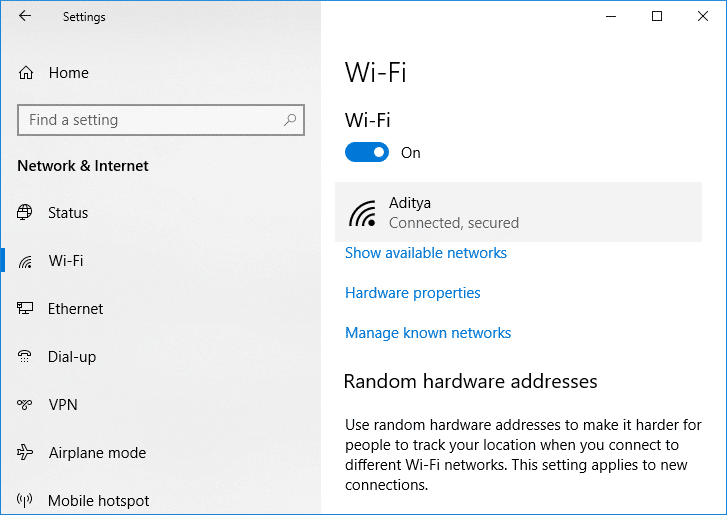
4. Scroll down to Metered connection and ටොගල සක්රිය කරන්න යටතේ "මීටර සම්බන්ධතාවයක් ලෙස සකසන්න".
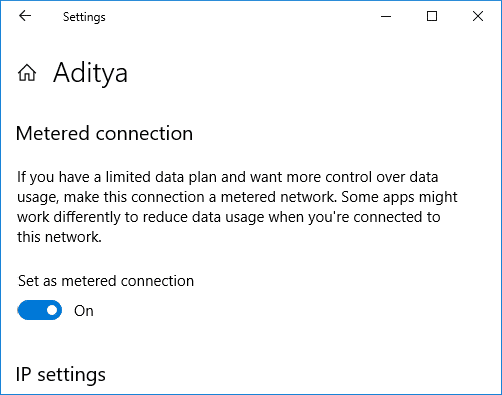
5. Close Settings and reboot your PC to save changes.
නිර්දේශ:
එච්චරයි, ඔබ සාර්ථකයි Fix Windows Modules Installer Worker High CPU Usage නමුත් ඔබට තවමත් මෙම නිබන්ධනය සම්බන්ධයෙන් කිසියම් විමසීමක් ඇත්නම්, අදහස් දැක්වීමේ කොටසේ ඔවුන්ගෙන් විමසීමට නිදහස් වන්න.
